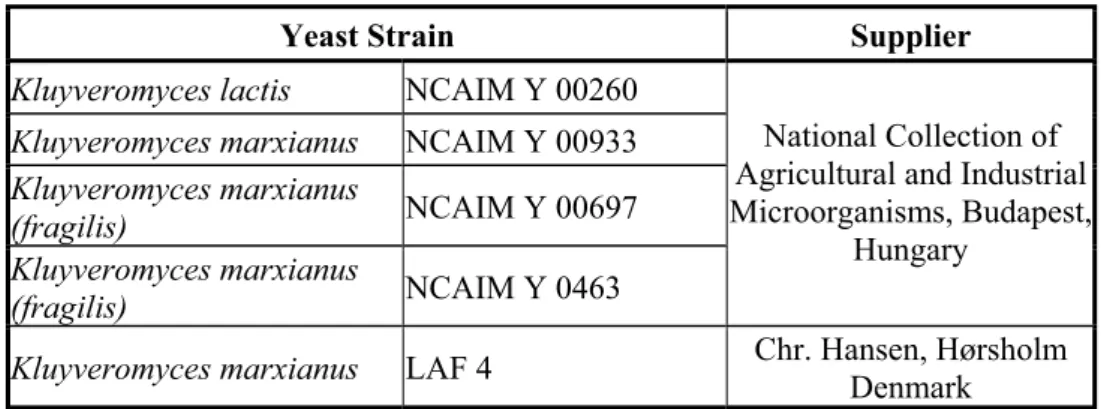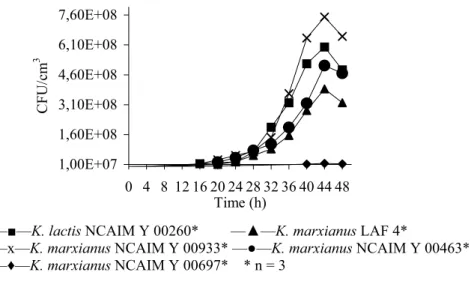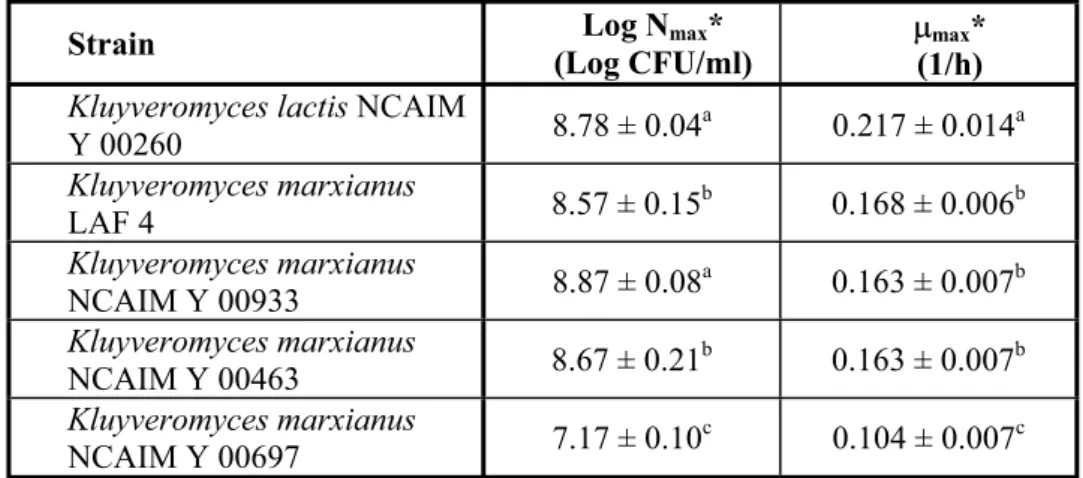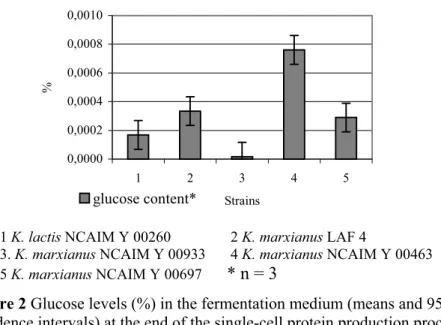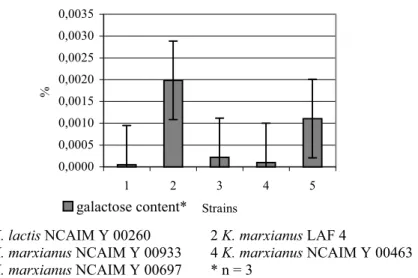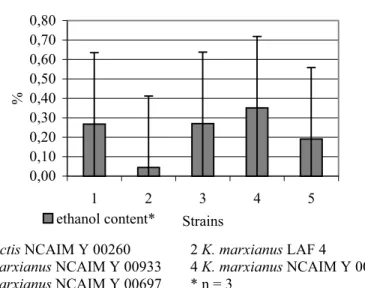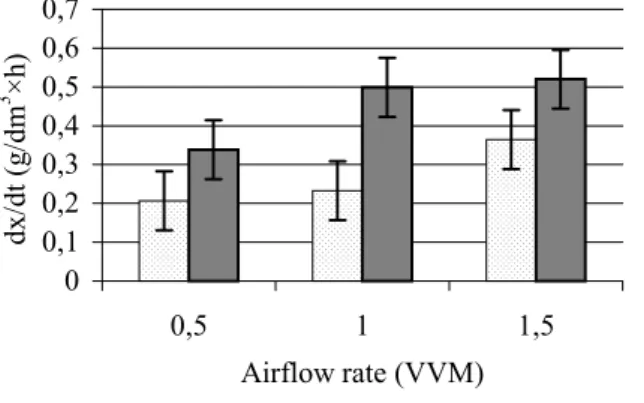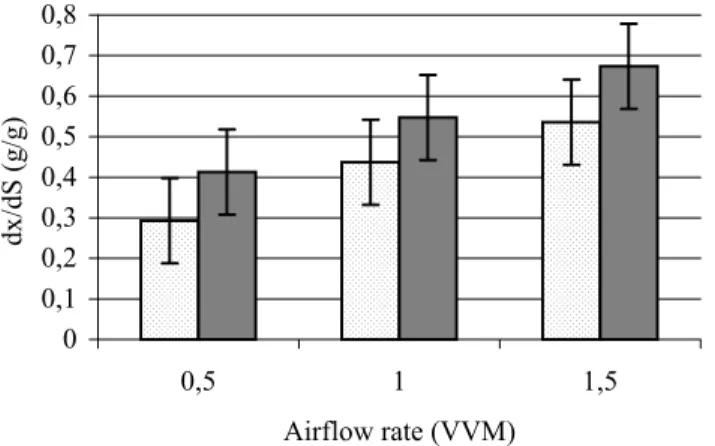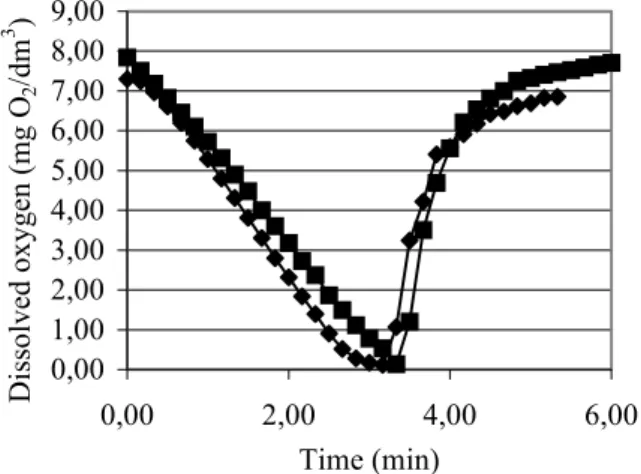UNIVERSITY OF WEST HUNGARY
FACULTY OF AGRICULTURAL AND FOOD SCIENCES MOSONMAGYARÓVÁR
Institute of Food Science
Head of Doctoral School:
Prof. Dr. János Schmidt Corresponding Member of HAS Program Director and Dissertation Adviser:
Prof. Dr. habil JenĘ Szigeti C.Sc. in Agriculture
OPTIMIZATION OF SINGLE-CELL PROTEIN PRODUCTION USING KLUYVEROMYCES STRAINS
Written by:
BALÁZS ÁSVÁNYI
1 INTRODUCTION AND AIM
During manufacture of cheese and quarg products, approximately 970 million dm3 of sweet and sour whey are produced annually in Hungary. Only a very small proportion of this huge amount of whey is used for animal nutrition, and roughly 50% of the whey produced is used to formulate products, i.e., food and feedstuffs. The remainder is treated as waste. It is sometimes dumped into surface water or sprayed onto fields, thus causing damage to local ecosystems.
Because of high moisture content, it is not economic to transport the whey for drying. In addition, the energy costs of drying are extremely high. As a result, in view of the current sales prices, the manufacture of whey powder is not a profitable activity.
Whey may be used as a valuable raw material for a wide range of applications in the food, pharmaceutical and biogas industries. However, the amount of whey processed worldwide is only about half of the annual global whey output.
An alternative to the traditional uses of whey is the production of single-cell protein (SCP). During manufacture of SCP, whey is inoculated with appropriate yeasts, e.g., Kluyveromyces species. The lactose and lactate contents of whey provide nutrients for these microorganisms to grow properly and produce proteins. The finished product, which has a protein content of approximately 50%, is of high biological value (87%). After proper pretreatment, it is utilized in both human and animal nutrition as a food and feed supplement.
Starting in the 1950s, very intensive research activity had been focused on the issues of SCP production but then it largely slowed down due to economic reasons. However, because of the efforts made worldwide to reduce environmental load, the question of whey utilization has recently become a high-priority research topic again.
Although gene technology has opened up new ways in biotechnology, it has not changed the basics of technological processes. The parallel use of genetically engineered novel microbial strains and traditional biotechnological processes is expected in the future despite the fact that some of the inherited traits are not always stable enough.
The primary purpose of this research was to find a yeast strain suitable for use in commercial production of SCP from whey. The strains tested were to be screened for growth characteristics such as maximum viable cell count (Nmax) and maximum specific growth rate (µmax), therefore, the fermentation parameters providing optimum conditions for the strains to reach Nmax and µmax were determined first. The glucose, galactose, ethanol, and lactose contents of whey were also quantified during the trials.
The yeast strains were then graded on the basis of their production performance. For this reason, maximum total solids concentration (xmax) and yield values such as production rate (dx/dt) and biomass yield (Yx/S) were determined under optimum fermentation conditions.
Setting the optimum fermentation parameters determined in this study, together with the use of novel biotechnological procedures, may contribute to the development of an economic SCP production technology.
2 MATERIALS AND METHODS
Based on data reported in the scientific literature, two yeast species (i.e., Kluyveromyces marxianus and K. lactis) appeared to be viable candidates for use in SCP production from whey. As shown in Table 1, five strains belonging to the aforementioned two species were purchased for experimental purposes.
All these strains are available in Hungary, with four of them being deposited in a Hungarian culture collection. This fact is thought to be significant in terms of future commercial applications.
Table 1 Yeast strains employed in the experiments
Yeast Strain Supplier
Kluyveromyces lactis NCAIM Y 00260 Kluyveromyces marxianus NCAIM Y 00933 Kluyveromyces marxianus
(fragilis) NCAIM Y 00697
Kluyveromyces marxianus
(fragilis) NCAIM Y 0463
National Collection of Agricultural and Industrial Microorganisms, Budapest,
Hungary
Kluyveromyces marxianus LAF 4 Chr. Hansen, Hørsholm Denmark
The experiments were carried out in the accredited Central Laboratory of the Institute of Food Science at the University of West Hungary (microbiological and analytical laboratories).
were selected for further SCP production trials, in which xmax, dx/dt, and Yx/S were determined.
Both sets of experiments were performed in duplicate. The instruments used were calibrated before each measurement session. The data obtained were subjected to one-way and two-way analysis of variance using the general linear model procedure. Significant differences among the means were determined by using Duncan’s post-hoc test at P < 0.05.
3 RESULTS AND DISCUSSION 3.1 Optimum Fermentation Parameters
Temperature, pH, and agitation were set at 30°C, 4.5, and 300 rpm, respectively, during the trials. Airflow rate was at 0.5, 1.0, 1.5, or 2.0 VVM (air volume/medium volume per min).
3.2 Selection of Strains Based on Their Production Parameters
3.2.1 Maximum viable cell counts (Nmax) and maximum specific growth rates (µmax) reached by the strains tested
1,00E+07 1,60E+08 3,10E+08 4,60E+08 6,10E+08 7,60E+08
0 4 8 12 16 20 24 28 32 36 40 44 48 Time (h)
CFU/cm3
—Ŷ—K. lactis NCAIM Y 00260* —Ÿ—K. marxianus LAF 4*
—x—K. marxianus NCAIM Y 00933* —Ɣ—K. marxianus NCAIM Y 00463*
—Ƈ—K. marxianus NCAIM Y 00697* * n = 3
Figure 1 Growth curves of the strains tested
It is illustrated in Figure 1 that all the Kluyveromyces strains tested were measured to produce maximum viable cell counts at h 44. Maximum specific growth rates (Pmax) for the particular strains were then calculated from the viable cell counts obtained as shown in Table 2.
Table 2 Maximum logarithmic viable cell counts (Log Nmax) and maximum specific growth rates (Pmax) reached by Kluyveromycesstrains during single-cell
protein production
Strain Log Nmax*
(Log CFU/ml)
Pmax* (1/h) Kluyveromyces lactis NCAIM
Y 00260 8.78 ± 0.04a 0.217 ± 0.014a
Kluyveromyces marxianus
LAF 4 8.57 ± 0.15b 0.168 ± 0.006b
Kluyveromyces marxianus
NCAIM Y 00933 8.87 ± 0.08a 0.163 ± 0.007b
Kluyveromyces marxianus
NCAIM Y 00463 8.67 ± 0.21b 0.163 ± 0.007b
Kluyveromyces marxianus
NCAIM Y 00697 7.17 ± 0.10c 0.104 ± 0.007c
* Each value is the mean ± standard deviation of 3 trials.
abc Values without a common superscript letter in the same column are significantly different (P < 0.05).
As for the maximum viable cell counts, K. marxianus LAF 4 and K.
marxianus NCAIM Y 00463 showed significantly lower values (P < 0.05) than didK. marxianus NCAIM Y 00933 or K. lactis NCAIM Y 00260. However, K.
marxianus NCAIM Y 00697 produced the poorest result in this respect of all theKluyveromyces strains tested.
The maximum specific growth rate of K. lactis NCAIM Y 00260 was significantly higher (P < 0.05), whereas the Pmax of K. marxianus NCAIM Y 00697 was found to be significantly lower (P < 0.05) than the values reached by any of the other three strains.
3.3 Glucose Content of the Fermentation Medium
0,0000 0,0002 0,0004 0,0006 0,0008 0,0010
1 2 3 4 5
Strains
%
glucose content*
1K. lactis NCAIM Y 00260 2 K. marxianus LAF 4
3.K. marxianus NCAIM Y 00933 4 K. marxianus NCAIM Y 00463 5K. marxianus NCAIM Y 00697
* n = 3
Figure 2 Glucose levels (%) in the fermentation medium (means and 95%
confidence intervals) at the end of the single-cell protein production process using various Kluyveromycesstrains
Figure 2 indicates that K. marxianus NCAIM Y 00463 produced the significantly highest (P < 0.05) glucose level of all the strains tested in this study. The values reached by K. marxianus LAF 4 and K. marxianus NCAIM Y 00697 did not significantly differ (P > 0.05) from each other but were significantly higher (P < 0.05) than the results obtained for K. lactis NCAIM Y 00260 and K. marxianus NCAIM Y 00933. LSD95% = 0.0009.
3.4 Galactose Content of the Fermentation Medium
0,0000 0,0005 0,0010 0,0015 0,0020 0,0025 0,0030 0,0035
1 2 3 4 5
Strains
%
galactose content*
1K. lactis NCAIM Y 00260 2 K. marxianus LAF 4
3K. marxianus NCAIM Y 00933 4 K. marxianus NCAIM Y 00463 5K. marxianus NCAIM Y 00697 * n = 3
Figure 3 Galactose levels (%) in the fermentation medium (means and 95%
confidence intervals) at the end of the single-cell protein production process using various Kluyveromycesstrains
It is shown in Figure 3 that K. marxianus LAF 4 produced the significantly highest (P < 0.05) galactose level of all the strains tested in this study. The values reached by K. marxianus NCAIM Y 00933 and K. marxianus NCAIM Y 00697 did not significantly differ (P > 0.05) from each other. The results obtained for K. lactis NCAIM Y 00260 and K. marxianus NCAIM Y 00463 proved to be significantly lower (P < 0.05) than those obtained for K.
marxianusLAF 4 or K. marxianus NCAIM Y 00697. LSD95% = 0.001.
3.5 Ethanol Content of the Fermentation Medium
0,00 0,10 0,20 0,30 0,40 0,50 0,60 0,70 0,80
1 2 3 4 5
Strains
%
ethanol content*
1K. lactis NCAIM Y 00260 2 K. marxianus LAF 4
3K. marxianus NCAIM Y 00933 4 K. marxianus NCAIM Y 00463 5K. marxianus NCAIM Y 00697 * n = 3
Figure 4 Maximum ethanol levels (%) in the fermentation medium (means and 95% confidence intervals) produced by various Kluyveromycesstrains
No significant differences (P > 0.05) were found between the various Kluyveromycesstrains tested in terms of maximum ethanol levels measured in the fermentation medium (Figure 4).
3.6 Lactose Content of the Fermentation Medium
0,00 0,50 1,00 1,50 2,00
1 2 3 4 5
Strains
%
lactose content*
1K. lactis NCAIM Y 00260 2 K. marxianus LAF 4
3K. marxianus NCAIM Y 00933 4 K. marxianus NCAIM Y 00463 5K. marxianus NCAIM Y 00697 * n = 3
Figure 5 Lactose levels (%) in the fermentation medium (means and 95%
confidence intervals) at the end of the single-cell protein production process using various Kluyveromycesstrains
The final lactose levels produced by K. lactis NCAIM Y 00260 and K.
marxianus LAF 4 were significantly lower (P < 0.05) than those reached by K.
marxianus NCAIM Y 00933 or K. marxianus NCAIM Y 00697, but did not significantly differ (P > 0.05) from the value obtained for K. marxianus NCAIM Y 00463 (Figure 5). LSD95% = 0.433.
Our results show that the screened strains differed in their ȕ- galactosidase (EC 3.3.2.23) activity. Kluyveromyces lactis NCAIM Y 00260 and K. marxianus LAF 4 showed the highest lactase activity because their growth media had the lowest lactose concentrations by the end of the fermentation process. The medium used to grow K. lactis NCAIM Y 00260 also had decreased final galactose levels as compared to the other strains, and in terms of glucose content only K. marxianus NCAIM Y 00933 produced a value lower than that obtained for K. lactis NCAIM Y 00260. All these findings, together with the fact that K. lactis NCAIM Y 00260 reached the highest µmax
value (0.217 1/h), clearly indicate that this strain proved to be superior to all the other Kluyveromyces strains tested in terms of suitability for use in SCP production.
Although no significant differences (P > 0.05) were found between the strains tested in their maximum ethanol production, K. marxianus LAF 4 was less sensitive to oxygen limitation than the other strains, which all showed a slight diauxic growth.
3.7 Further Selection of Strains Based on Their Production Performance Based on their µmax values, two strains (i.e., K. lactis NCAIM Y 00260 and K. marxianus LAF 4) were selected for further SCP production trials.
Temperature, pH, and agitation were set at 30°C, 4.5, and 300 rpm, respectively, and airflow rate was at 0.5, 1.0, 1.5, or 2.0 VVM during the experiments. Both data reported in the scientific literature and the possibility of later commercial applications were taken into consideration when the above operation parameters were determined.
3.7.1 Maximum total solids concentration (xmax)
0,00 5,00 10,00 15,00 20,00 25,00 30,00 35,00
0,5 1,0 1,5
Airflow rate (VVM) xmax (g/dm3 )
K. marxianus LAF 4 K. lactis NCAIM Y 00260
Figure 6 Maximum total solids levels (xmax) reached by the selected strains (means and 95% confidence intervals)
The maximum total solids values reached by both K. lactis NCAIM Y 00260 and K. marxianus LAF 4 at the airflow rate of 1.5 VVM were significantly higher (P < 0.05) than the corresponding results obtained at lower aeration levels (Figure 6). The xmax of K. lactis NCAIM Y 00260 at 1.0 VVM was the only exception to this rule. LSD 95% = 4.23.
At the airflow rates of 0.5 VVM and 1.0 VVM, significant differences (P < 0.05) were found between the two strains in terms of their xmax values.
LSD95% = 3.45.
3.7.2 Production rate (dx/dt)
0 0,1 0,2 0,3 0,4 0,5 0,6 0,7
0,5 1 1,5
Airflow rate (VVM) dx/dt (g/dm3 ×h)
K. marxianusLAF 4 K. lactisNCAIM Y 00260
Figure 7 Production rates (dx/dt) of the selected strains (means and 95%
confidence intervals)
The production rates of K. lactis NCAIM Y 00260 were significantly higher (P < 0.05) at 1.0 VVM and 1.5 VVM than at 0.5 VVM, whereas the dx/dt values obtained for K. marxianus LAF 4 were significantly higher (P <
0.05) at 1.5 VVM than at lower airflow rates (Figure 7). LSD95% = 0.075.
Kluyveromyces lactis NCAIM Y 00260 had significantly higher (P <
0.05) production rates at all three aeration levels than did K. marxianus LAF 4.
LSD95% = 0.062.
3.7.3 Biomass yield (Yx/S)
0 0,1 0,2 0,3 0,4 0,5 0,6 0,7 0,8
0,5 1 1,5
Airflow rate (VVM)
dx/dS (g/g)
K. marxianus LAF 4 K. lactis NCAIM Y 00260
Figure 8 Biomass yield (Yx/S) of the selected strains (means and 95%
confidence intervals)
Figure 8 illustrates that biomass yield increased with increasing airflow rate. There were significant differences (P < 0.05) between the means of K.
lactis NCAIM Y 00260 at all three aeration levels. As for K. marxianus LAF 4, the measured Yx/S values were significantly higher (P < 0.05) at 1.0 VVM and 1.5 VVM than at 0.5 VVM. LSD95% = 0.105.
Kluyveromyces lactis NCAIM Y 00260 produced significantly higher
oxygen absorption coefficients (KLa), and saturation oxygen concentrations (C*) were determined for both strains at 1.5 VVM. For this, the following equation, which describes the respiration of microorganisms, was used:
dC/dt = KLa×(C*-C)-xQ (kg O2/m3×h) [1], where:
a: mass transfer surface per volume (cm-1)
KLa: liquid-phase oxygen absorption coefficient (h-1) C*: saturation oxygen concentration (mg/dm3)
C: measured dissolved oxygen concentration (mg/dm3) x: cell mass (g)
Q: specific respiration rate (h-1).
3.8.1 Dynamic determination of KLa
Dissolved oxygen concentration (C) changes characteristically during fermentation. If this parameter is plotted against time, C* and KLa can be determined (Figure 9).
0,00 1,00 2,00 3,00 4,00 5,00 6,00 7,00 8,00 9,00
0,00 2,00 4,00 6,00
Time (min) Dissolved oxygen (mg O2/dm3 )
Ŷ Dissolved oxygen levels* in the case of K. marxianus LAF 4 Ƈ Dissolved oxygen levels* in the case of K. lactis NCAIM Y 00260
* n = 3
Figure 9 Dynamic determination of KLa
Because dC/dt=-xQ when aeration is stopped, and x and Q are practically constant, the decreasing phase of the curve is a straight line. Its slope is the respiration rate. The respiration rates of K. lactis NCAIM
Y 00260 and
K. marxianus LAF 4 in the decreasing phase of the curve (dC/dt) were found to be 2.85 mg O2/dm3×min and 2.40 mg O2/dm3×min, respectively.
The KLa results calculated from the equation of the line fitted to the values obtained by plotting the linearized form of equation [1] were 227 h-1 and 187 h-1 for K. lactis NCAIM Y 00260 and K. marxianus LAF 4, respectively.
C*, which is obtained by putting the dC/dt values in the equation of the line, was 6.63 mg/dm3 in the case of K. lactis NCAIM Y 00260 and 7.5 mg/dm3 for K. marxianus LAF 4.
4 NEW SCIENTIFIC FINDINGS
1. The fermentation parameters providing optimum conditions for K. lactis NCAIM Y 00260, K. marxianus LAF 4, K. marxianus NCAIM Y 00933, K.
marxianusNCAIM Y 00463, and K. marxianus NCAIM Y 00697 to reach maximum viable cell counts and maximum specific growth rates during single-cell protein production were determined as follows: temperature of 30°C, pH of 4.5, agitation of 300 rpm, and airflow rate of 2.0 VVM. The glucose, galactose and ethanol levels produced under these optimum conditions in the fermentation media were measured, and the efficiency of lactose conversion was also quantified.
2. The maximum total solids concentration, biomass yield, and respiration rate values of K. lactis NCAIM Y 00260 and K. marxianus LAF 4 were determined during batch production of single-cell protein from sweet whey under the following operation conditions: temperature of 30°C, pH of 4.5, agitation of 300 rpm, and airflow rates of 0.5, 1.0, and 1.5 VVM.
3. Of all the Kluyveromyces strains tested, K. lactis NCAIM Y.00260 proved to be the strain most suitable for use in whey-based single-cell protein production.
5 SCIENTIFIC PUBLICATIONS AND PRESENTATIONS ON THE TOPIC OF THE Ph.D. DISSERTATION
Oral Presentations Given at Scientific Conferences and Symposia In Hungarian
Kovács, P., Szigeti, J., Ásványi, B. (2003): Savó alapú egysejtfehérje elĘállítása. OMFB Szakmai beszámoló. Budapest.
Abstracts of Scientific Presentations In Hungarian
Ásványi, B., Szigeti, J. (2003): Egysejtfehérje elĘállítására alkalmas élesztĘk szaporodásának összehasonlítása. MTA ÉKB – KÉKI – MÉTE 312. Tudományos Kollokvium elĘadásainak rövid kivonata. Budapest, 2003. szeptember. 284, 6.
Ásványi, B., Szigeti, J. (2002) Tejipari melléktermékek fehérje- és vitamintartalmának dúsítása (Enrichment of protein and vitamin contents in dairy by-products). XXIX. Óvári Tudományos Napok
“Agrártermelés – ÉletminĘség”. Az elĘadások és poszterek összefoglaló anyaga, Élelmiszer-tudományi Szekció, Mosonmagyaróvár, 100.
In English
Ásványi, B., Bugyi, G., Daróczi, L., Kovács, R., Szigeti, J., Varga, L.
(2003) Growth of yeast strains during batch production of single-cell protein from cheese whey. 1st FEMS Congress of European Microbiologists. Abstract Book, Ljubljana, 103–104.
Ásványi, B., Kovács, R., Szigeti, J., Varga, L., Kovács, P. (2003) Selection of Kluyveromyces strains for batch production of single-cell protein from cheese whey. 23rd International Specialised Symposium on Yeasts “Interaction Between Yeasts and Other Organisms”. Book of Abstracts, Budapest, 156.
Kovács, R., Vecseri-Hegyes, B., Ásványi, B., Varga, L., Szigeti, J., Daróczi, L., Bugyi, G. (2003) Manufacture of honey beer with Saccharomyces cerevisiae and Saccharomyces pastorianus. 1st FEMS Congress of European Microbiologists. Abstract Book, Ljubljana, 117–
118.
Kovács, R., Vecseri-Hegyes, B., Ásványi, B., Varga, L., Szigeti, J., Daróczi, L., Bugyi, G. (2003) Suitability of Saccharomyces cerevisiae andSaccharomyces pastorianus for use in honey beer production. 23rd International Specialised Symposium on Yeasts “Interaction Between Yeasts and Other Organisms”. Book of Abstracts, Budapest, 188.
Ásványi, B., Szigeti, J., Varga, L. (2004) Suitability of Kluyveromyces spp. for use in single-cell protein production from sweet cheese whey.
American Dairy Science Association – American Society of Animal Science – Poultry Science Association 2004 Joint Annual Meeting.
Abstracts, St. Louis, Missouri: Journal of Animal Science 82 (Supplement 1) / Journal of Dairy Science 87 (Supplement 1) / Poultry Science83 (Supplement 1) 384.
Papers Published in Proceedings In Hungarian
Ásványi, B., Szigeti, J., Varga, L. (2003) ÉlesztĘtörzsek szaporodásának összehasonlítása szakaszos egysejtfehérje-elĘállítási folyamatban (Comparing the growth of yeast strains during batch production of single-cell protein). 31. MĦszaki Kémiai Napok. Az elĘadások teljes terjedelemben megjelent anyagai, Veszprém, 295–299.
Ásványi, B., Szigeti, J., Varga, L. (2004) Savó alapú egysejtfehérje elĘállítás (Single-cell protein production from cheese whey). XXX.
Óvári Tudományos Napok “Agrártermelés – Harmóniában a Természettel”. Az elĘadások és poszterek teljes terjedelemben
Ásványi, B., Szigeti, J., Varga, L. (2005) A savó, mint tejipari melléktermék élesztĘgombákkal történĘ hasznosítása (Utilization of whey as a dairy byproduct by yeasts). Acta Agronomica Óváriensis 47 (2) (közlésre elfogadva).
Ásványi, B., Szigeti, J., Varga, L. (2005) Kluyveromyces törzsek összehasonlítása sajtsavó alapú szakaszos egysejtfehérje-elĘállítás során (Comparison of Kluyveromyces strains in terms of suitability for use in batch production of single-cell protein from cheese whey). Acta Agronomica Óváriensis47 (2) (közlésre elfogadva).
In English
Ásványi, B., Reichart, O., Szigeti, J., Varga, L. (2006) Screening and selection of Kluyveromyces strains for use in batch production of single- cell protein from cheese whey. Milchwissenschaft 61 (accepted for publication).
